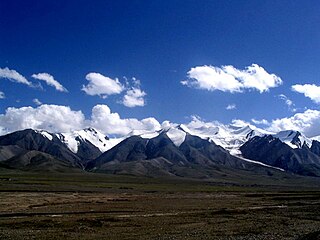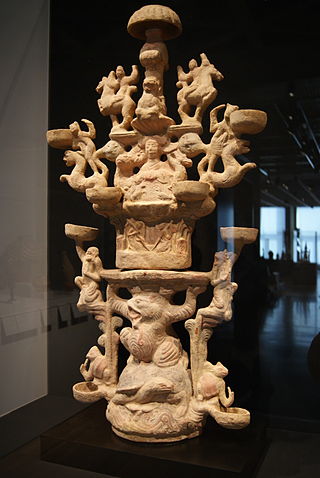
Chinese mythology is mythology that has been passed down in oral form or recorded in literature throughout the area now known as Greater China. Chinese mythology includes many varied myths from regional and cultural traditions. Much of the mythology involves exciting stories full of fantastic people and beings, the use of magical powers, often taking place in an exotic mythological place or time. Like many mythologies, Chinese mythology has in the past been believed to be, at least in part, a factual recording of history. Along with Chinese folklore, Chinese mythology forms an important part of Chinese folk religion and Taoism, especially older popular forms of it. Many stories regarding characters and events of the distant past have a double tradition: ones which present a more historicized or euhemerized version and ones which present a more mythological version.

Nüwa, also read Nügua, is a mother goddess, culture hero, and/or member of the Three Sovereigns of Chinese mythology. She is a god in Chinese folk religion and Taoism. She is credited with creating humanity and repairing the Pillar of Heaven.

The Kunlun Mountains constitute one of the longest mountain chains in Asia, extending for more than 3,000 kilometres (1,900 mi). In the broadest sense, the chain forms the northern edge of the Tibetan Plateau south of the Tarim Basin.
Gonggong is a Chinese water god who is depicted in Chinese mythology and folktales as having a copper human head with an iron forehead, red hair, and the body of a serpent, or sometimes the head and torso are human, with the tail of a serpent. He is destructive and is blamed for various cosmic catastrophes. In all accounts, Gonggong ends up being killed or sent into exile, usually after losing a struggle with another major deity such as the fire god Zhurong.
Hundun is both a "legendary faceless being" in Chinese mythology and the "primordial and central chaos" in Chinese cosmogony, comparable with the world egg.

In astronomy, axis mundi is the Latin term for the axis of Earth between the celestial poles.
Chinese creation myths are symbolic narratives about the origins of the universe, earth, and life. Myths in China vary from culture to culture. In Chinese mythology, the term "cosmogonic myth" or "origin myth" is more accurate than "creation myth", since very few stories involve a creator deity or divine will. Chinese creation myths fundamentally differ from monotheistic traditions with one authorized version, such as the Judeo-Christian Genesis creation narrative: Chinese classics record numerous and contradictory origin myths. Traditionally, the world was created on Chinese New Year and the animals, people, and many deities were created during its 15 days.

In Chinese mythology, Peaches of Immortality are consumed by the immortals due to their mystic virtue of conferring longevity on all who eat them. Peaches symbolizing immortality are a common symbol in Chinese art, appearing in depictions or descriptions in a number of fables, paintings, and other forms of art, often in association with thematically similar iconography, such as certain deities or immortals or other symbols of longevity, such as deer or cranes.
Mount Buzhou was an ancient Chinese mythological mountain which, according to old texts, lay to the northwest of the Kunlun Mountains, in a location today referred to as the Pamir Mountains. It is the mountain said to have supported the heavens, against which the Chinese water god Gonggong smashed his head in a fit of anger, requiring the goddess Nüwa to repair the sky. Nevertheless, once the spacer between the Earth and Sky was damaged, the land of China was permanently tilted to the southeast, causing all the rivers to flow in that same direction.

The Queen Mother of the West, known by various local names, is a mother goddess in Chinese religion and mythology, also worshipped in neighbouring Asian countries, and attested from ancient times. From her name alone some of her most important characteristics are revealed: she is royal, female, and is associated with the west.

The Kunlun or Kunlun Shan is a mountain or mountain range in Chinese mythology, an important symbol representing the axis mundi and divinity.
Jade Mountain is a mythological mountain in Chinese mythology and the residence of The Queen Mother of the West.
Feather Mountain is one of many important mythological mountains in Chinese mythology, particularly associated with the Great Flood. According to the mythological studies of Lihui Yang, Gun was executed on the "outskirts" of Feather Mountain by Zhu Rong, either for stealing the xirang or for failing to control the flood waters. According to K. C. Wu, Emperor Shun exiled Gun to Feather Mountain for lèse-majesté, but that Gun was not executed; and, rather, that such accounts result from misunderstanding the meanings associated with the ancient Chinese character jí (殛), which appears in certain source works.
The Flood Mythology of China, or Great Flood of China is a deluge theme which happened in China. Derk Bodde (1961) stated that "from all mythological themes in ancient Chinese, the earliest and so far most pervasive is about flood." The mythology also has shared characteristics with other Great Floods all over the world, although it also has unique characteristics or different focuses. Lu Yilu (2002) groups all versions of great flood into three themes: "the heroes controls the flood; "brother-sister marriage to repopulating the world"; and "the flood which is drowning the whole city along with its citizens".
The Eight Pillars also known as Eight Pillars of the Sky are a concept from Chinese mythology. Located in the eight cardinal directions, they are a group of eight mountains or pillars which have been thought to hold up the sky. They are symbolically important as types of axis mundi and cosmology. Their functions in mythology ranged from pillars which functioned to hold apart the Earth and the Sky, as ladders allowing travel between the two, and as the location of various paradises or wonderland with associated magical people, plants, and animals. The Eight Pillars are a central aspect to Chinese mythology, and also have been used extensively in poetic allusion. Some variations exist, such as only having four pillars.

The Weak River also known as the Weak Water or Ruoshui is an important feature in the mythical geography of Chinese literature, including novels and poetry over a course of over two millennia from the Warring States to early Han dynasty era poetry of the Chuci onward. The Weak River is one of the mythological rivers flowing near Kunlun, home of a Western Paradise. The Weak River flowed with "water" so lacking in specific gravity that even a feather would not float, thus being a protective barrier against the unworthy, who otherwise would profane the paradise on Kunlun, and perhaps even climb up to Heaven and disturb the deities and other inhabitants residing there. In the novel Journey to the West, the Weak Water River forms one of the obstacles the fictional version of the monk Xuanzang, the magic monkey Sun Wukong, and companions must cross over on their mission to fetch the Buddhist scriptures from India and return them to Tang China.
The Red River or Red Water is an important feature in the mythological geography of Chinese literature, including novels and poetry over a course of over two millennia from the Warring States to early Han dynasty era poetry of the Chuci onward. The Red River is one of the mythological rivers said to flow from Kunlun, a mythological land, with mountainous features. Translations into English include "Scarlet River".

The Moving Sands, also known as the Flowing Sands, is an important feature in the mythological geography of Chinese literature, including novels and poetry over a course of over two millennia from the Warring States to early Han dynasty era poetry of the Chuci onward to the present. In his poem "Li Sao", author Qu Yuan describes an aerial crossing of the Moving Sands on a shamanic spiritual Journey to Kunlun. "Moving Sands forms one of the obstacles the fictional version of the monk Xuanzang and companions must cross over on their mission to fetch the Buddhist scriptures from India and return them to Tang China. In this story, Xuanzang recruits the former sand demon and eater-of-humans Sha Wujing who is living in Moving Sands as his third disciple. Sometimes the Moving Sands seem to depict drifting dunes or desert, sometimes a sand or quicksand-like river, in which case, in Chinese, it would be (Liúshā-hé.

Chinese mythological geography refers to the related mythological concepts of geography and cosmology, in the context of the geographic area now known as "China", which was typically conceived of as the center of the universe. The "Middle Kingdom" thus served as a reference point for a geography sometimes real and sometimes mythological, including lands and seas surrounding the Middle Land, with mountain peaks and sky above, with sacred grottoes and an underworld below, and even sometimes with some very abstract other worlds.